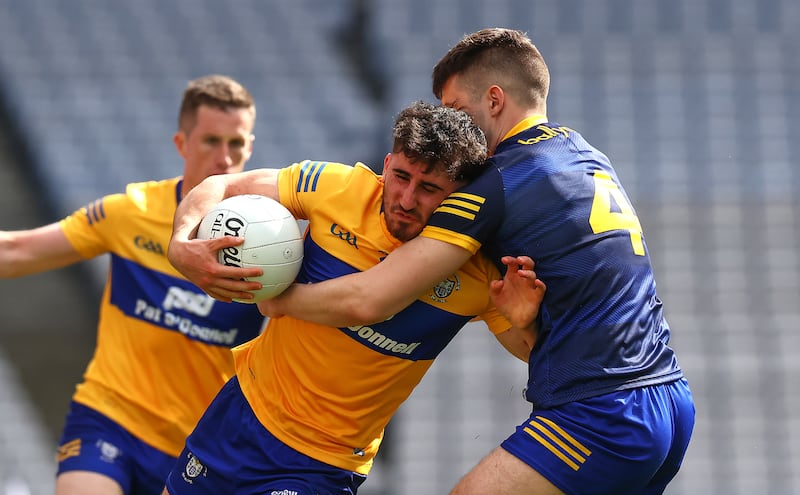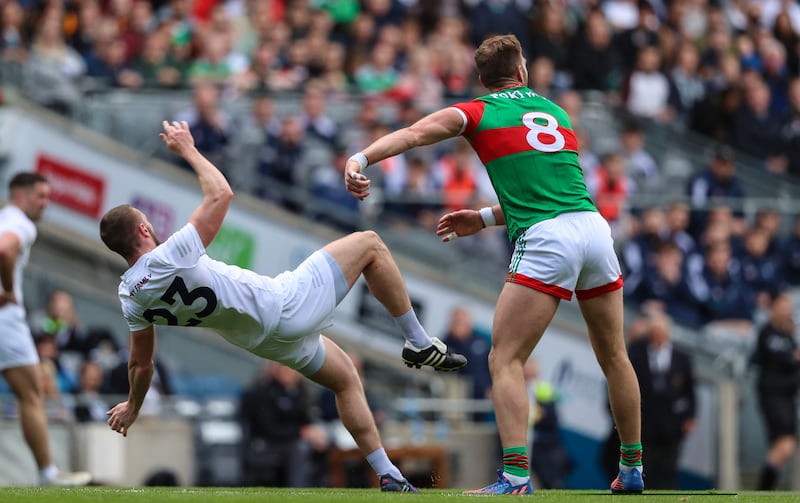This is always my favourite time in the championship summer. It’s busy and teeming with storylines and intrigue. The final round of the qualifier system always produces a surprise. It is, invariably, a weekend of glorious redemption for the losers. It’s an opportunity to shake off the cloak of loss.
In 2016, I was managing Roscommon when we lost to Clare for a place in the last eight. In 2018 we beat Armagh in a cracker in Portlaoise. So I understand both sides of that coin. You are bereft when you lose. The world just stops. It leaves you with months of contemplation and it leads to the usual questions.
Some players will retire. Some managers will move on. But often, the true, necessary questions are rarely asked −and therefore never answered. Supporters and county boards like to be presented with a package of where the blame lies. But that package rarely contains the truths that those counties need to arrive at.
But when you win it is euphoria. A team feels as though it can take on the world. So it went this weekend. This year’s qualifiers have been a blazing success. This was partly a consequence of the advent of the Tailteann Cup, leaving closely matched, mainly heavyweight teams to fight it out for the All-Ireland quarter-final places.
In the two decades since the qualifying system was dreamed up, there have been three or four different iterations. Ironically, this year’s system was clearly the best. Monaghan-Mayo went down to the wire. Armagh sent the All-Ireland champions crashing out. And this weekend, we had an exuberant late flowering by Clare and Armagh’s ransacking of Donegal on Sunday.
And now, of course, the qualifying concept is dead and gone as a system and will be replaced by another experiment: the groups of four to be played next year. It seems a shame that the qualifying idea is disappearing now that it has finally been perfected. At least it went out with a bang.
And it confirmed an old trend. The provincial final losers have always borne the brunt of the qualifying system. Once again, all four provincial losers − Donegal, Kildare, Roscommon and Limerick – could not overcome the setback of losing their respective finals. Defeat in a provincial final can break something vital within a team. It is sapping. The effort they put in to prepare is commendable but losing that final carries a huge cost.
There isn’t a doubt in my mind that all teams and managers lean towards defence first and foremost as a basis of any advancement
Saturday saw the exit of two teams I feel share a lot of similarities, Roscommon and Kildare. Both have better than average forward lines and want to play to those strengths but are continually undermined by less than average defences.
Obviously, I know a little about the Roscommon model but a few weekends back when working on the Kildare v Westmeath semi-final in Leinster I was astounded to see the lack of marking, tracking, tackling, physicality by the Kildare back six and their helpers.
It was non-existent and I noted at the time that only one result could follow in the final if this massive deficit was not addressed. Dublin duly pummelled them a few weeks later.

It’s pretty much the same scenario with Roscommon. The easy summary is to believe neither team cares about defending and they don’t practice it that much. But that is simply not true. Roscommon had a specialist defensive coach over the years, as many others do too. Cian O’Neill coached Kildare in recent times also.
There isn’t a doubt in my mind that all teams and managers lean towards defence first and foremost as a basis of any advancement. So why are defensive structures so frequently exposed? Why do teams collapse like the way we saw Donegal collapse on Sunday? And what does a modern defence look like anyhow?
In general, you have two different options when it comes to set-up: two or three banks of defensive lines (three in each line) from your 45-metre line already in position to meet the opposition attack, with your full-back line often on match-up duty and, finally, an extra midfielder falling back to further congest the central defensive area around the ‘D’.
Or you might go for a mixture of weak-side defence with a sweeper. In this scenario, the pitch is basically divided longitudinally into three and the idea is to encourage the opposition to attack on one side or the other buy never the central channel. In this way you establish a weak side to your defence (the side the ball is not on) and from here you sag redundant defenders back into the danger area.
An example: the opposition are attacking down the Cusack Stand side – your No 2 and 5 are essentially marking players that are not likely to be part of the play at any moment soon and so you can afford to ‘cheat in’ to the goal area and provide more bodies and protection here.
Engaged defending requires ferocious fitness levels, a serious collective pace, structure and a commitment to physical contact
There may be other additions to this system, such as the weak-side midfielder who heads for the ‘D’ once the ball is at 90 degrees to him and, likewise, the No 10 heads back once the ball goes Cusack side. The 11 goes to midfield for the outlet (when the ball is won back) and the 14 goes to 11 position to provide linkage between the lines. The two corner men set up centrally in the full-back line as targets/outlets.
It is this kind of drift, patient system which has been the source of much frustration from fans and pundits alike, who bemoan the phenomenon of what appears to be ‘passive defending’.
The tenacity and bite that is part of the tradition of Gaelic football is nowhere in evidence. In fact, many modern defenders don’t seem to consider it to be part of their brief at all. It seems as if they do not like that physical contact and are happy to shadow their man. It creates a risk-averse attitude which can also influence the attacking approach – with lateral foot and hand passes and a reluctance to make the angled, incisive runs required to break a line.

It’s a calculated gamble on the part of those teams and their coaches. For the public, it means the sight of sweepers merely waving and pointing at attackers rather than meeting them; the continuous shadowing of attackers; little or no physical contact – and an approach that seems to suggest: shoot from distance if you think you’re good enough . . . we don’t care about those ones!
Engaged defending requires ferocious fitness levels, a serious collective pace, structure and a commitment to physical contact. It is notable that the four provincial champions have these attributes – even if Derry are wedded to an inherently defensive game plan. But it is the major deficit in the Kildare and Roscommon defence for years and now Donegal have fallen into that group also.
Of course, another group who famously have those qualities in abundance are the magical mystery train that is Mayo. So, what are we to make of Mayo in their latest arrival as last-eight contenders?
On the surface, they looked all over the shop. They were disjointed for threequarters of their game against Kildare. They gave the Lilywhites every chance to beat them. But they kept on plugging and sticking with it and never panicked – the stuff we have seen before. And then, just when it all seems lost, they catch fire and romp home. They are daft as a bag of frogs.
They got away with 50 poor minutes against Dublin last year. But the Monday morning draw pairs them with a team who will massacre them if they produce another sub-par 50-minute spell. Kerry will be wary of Mayo’s potential for unreasonableness. Athletically, physically and more importantly in match-ups, Mayo will not be found wanting.
But nobody outside the Mayo bubble will see them winning that game. Still, it gives Mayo a chance to show that the league final was just an aberration. And the nagging doubt at the back of Jack O’Connor’s mind is that they haven’t had a serious game in quite some time.
But the story of the weekend is surely Armagh footballers. Of all the winners, they have emerged as a serious threat.
More and more, at this stage of the championship especially, a black card is turning into five or so points and is a dangerous outcome for any team
After the effort put into hammering Tyrone, I felt the energy levels might be a little low a week later. What many failed to factor in in that Tyrone win was the quality of football played they produced. And if they could repeat those high-class moments then, yes, Donegal would be put to the sword.
The game started in a blaze and confirmed what many of us have been predicting for some time. The modern throw-in has become almost beyond the control of the referees with the pulling and poking that is going on to block, barge and hold down before the ball is even thrown in.
Refs are blowing their whistles almost immediately on throw-in for a foul they are often not too sure about. And the pulling and dragging usually leaves one of the midfielders disengaged on the wrong side and unable to defend if the opposition win and go for goal. This time Armagh went long and a few seconds later had scored the goal of the season, perhaps. It was beautiful in its elemental simplicity and cleanness. Bang, bang, goal.
And then for 10 or 20 mins we saw the very best of Donegal until yet another piece of goalkeeping madness turned the game upside down: a dangerous kick-out is mishandled and a turnover in front of your goal ensues. A few moments later it’s a penalty and a black card and the game is quickly contorted into a shape that Donegal simply prove unable to deal with.
More and more, at this stage of the championship especially, a black card is turning into five or so points and is a dangerous outcome for any team. But it is a grievous blow when your goalkeeper is the culprit.
That few seconds unhinged Donegal but the day confirmed that Armagh are the emergent force in Ulster. We were left not just admiring the 11-point winning margin but recalling that Armagh also butchered two simple goal chances and left a few points behind them too.
Their confidence must be soaring now, and they have happy memories of Croke Park dating back to the league. They have a bracing, engaged defence and, most importantly, they have some very fine footballers. They are the shark in the water even as the beaches fill up.


















